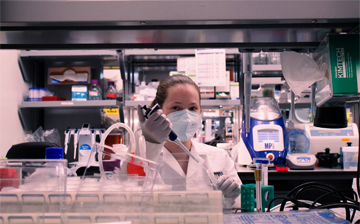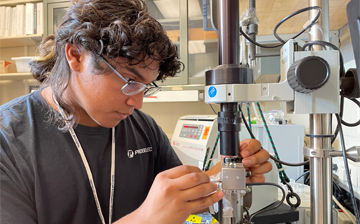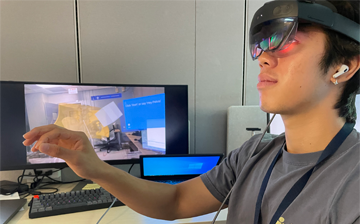NIBIB internships can open doors to new perspectives on research, career opportunities and much more.
Doors opened this summer for 24 university students, recruited by the Biomedical Engineering Summer Internship Program (BESIP) and Center for Biomedical Engineering Technology Acceleration (BETA Center), who had the opportunity to work with cutting-edge biomedical technology under the direction of top-flight experts on NIH campus.
The interns, with the support of the Office of Intramural Training and Education (OITE), focused on research projects based in 10 different institutions and centers across NIH. Here's an overview of what a few NIBIB interns worked on and took from the experience:
Maya Evohr
Maya is a rising senior at Worcester Polytechnic Institute studying biomedical engineering. Maya’s research interests lie in the fields of tissue engineering and biomaterials.

Her project this summer centers on better understanding how certain proteases in the body interact with and influence the infectiousness of SARS-CoV-2. To conduct this work, Maya has built on her existing cell culture experience and developed brand new skills in protein analysis.
Maya is finishing a joint bachelor's and master’s degree in biomedical engineering and plans to pursue a Ph.D. to establish her own tissue engineering lab in the future and set an example for students who haven’t seen themselves represented in STEM.
Jacob Arras
Jacob Arras is a rising junior studying biomedical engineering at the University of Texas at San Antonio, passionate about biochemistry, medical technology, and the environment.

For his project at NIBIB this summer, Jacob used atomic force microscopy to examine the physical properties of surface proteins from the malaria-causing parasite Plasmodium vivax. The data from this research could help identify candidate proteins for new malaria vaccines.
Jacob plans to complete his biomedical engineering undergraduate degree and then pursue a graduate education that will allow him to conduct research impacting environmental and human health.
Alessandra Coogan
Alessandra is a biomedical engineering graduate student at George Mason University who thrives in collaborative environments and is interested in tissue engineering.

Her focus this summer was characterizing a hydrogel-based nasal spray for treating fungal respiratory infections, which could reduce the risk of side effects compared to standard treatment. To understand whether the biomaterial is suited to the task, she has analyzed mechanical properties of the gel and how it affects lung cells.
By working alongside an array of experts on campus, Alessandra has learned new skills and perspectives that will benefit her career moving forward. She plans on completing her accelerated master’s program next spring and then continuing her training to become a tissue engineering researcher.
Johnathan Mo
Johnathan Mo is a rising sophomore with a knack for programming and a keen interest in the computational side of medicine. He will study computer science at Columbia University this fall.

Johnathan’s research at NIBIB this summer introduced him to the world of augmented reality (AR). For his project, he developed new functionalities for AR platforms that would allow clinicians to use voice commands to operate AR interfaces — during a surgery, for example — and also collaborate remotely.
As he continues his undergraduate education, Johnathan seeks to explore subjects such as computational biology and brain-computer interfaces, eventually diving further into his interests in graduate school.
